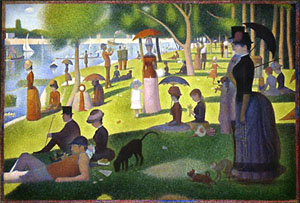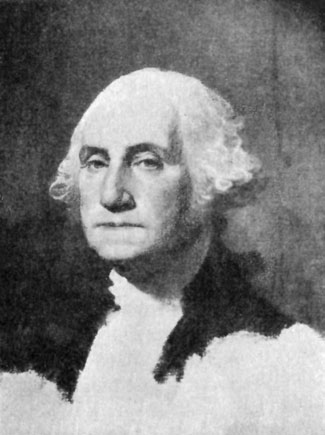My list of over-seen masterpieces

Thanks to everyone who has answered the call of my earlier query. Many excellent ideas have been put forth and I encourage further thought on this.
Here is a list I compiled while leafing through Sister Wendy Beckett’s history of painting. It is all “usual suspects” and is intended to weed out the over-seen.



Van Gogh: Self-Portrait, Starry Night (above), Sunflowers, The Artist’s Bedroom
Botticelli’s Birth of Venus (see previous entry)

Rembrandt Self-portrait




Picasso: Guernica, Old Guitarist, Three Musicians, Les Demoiselles d’Avignon

Munch’s Scream

Dali: Persistence of Memory

Seurat’s La Grande Jatte

Head of Nefertiti
Greek discus thrower


Rodin: The Kiss, The Thinker

Lacoon and His Two Sons

Gutenberg Bible

First Folio

Eyck’s Arnolfini Marriage

Bosch’s Garden of Earthly Delights

Davinci’s Universal Man

Breugal’s Tower of Babel

David’s Death of Marat

Vermeer’s Girl with a Pearl Earring

Gainsborough’s The Blue Boy

Gilbert Stuart’s Unfinished Portrait of George Washington

Ingres’s Grande Odalisque

Goya’s May 3, 1808

Gericault’s Raft of the Medusa

Whistler’s Arrangement in Black and Gray: the Artist’s Mother

Wood’s American Gothic


Manet: Le Dejeuner sur Herbe, Bar at Folies-Bergere

Monet: Waterlily Pond

Klimt: The Kiss

Brancusi: The Kiss, Bird in Flight

Rousseau’s Sleeping Gypsy

Warhol’s Gold Marylin

Mondrian’s Broadway Boogie Woogie

Matisse’s Dance

Magritte’s Apple-face guy (already taken by Thomas Crown, I’m afraid)

Giocometti’s Walking Man

Reinhardt’s Abstract Painting #5


Rauschenberg: Monogram, Canyon

Lichtenstein: Whaam!
Degas: Prima Ballerina

Renoir: Le Moulin de le Galette (God I hate Renoir)

Cezanne’s Fruit Bowl, Glass and Apples

Robert Indiana’s Love

Jasper John’s Three Flags
Then there are a handful of 20th-century guys who don’t really have one standout work (at least not in popular consciousness) but who’s stuff would be recognized as a type: Rothko, Pollock, Calder, De Kooning, and to some extent Warhol.

Maxfield Parrish’s Daybreak!
I’m usually flummoxed by these requests, which I get a surprising amount of: “select something that everyone knows, but not everyone knows”. Maybe I’m just too sensitive to the widely moving target of cultural awareness.
Urbaniak and I were once in Paris together, waiting in line at the Orsay to see some Manet still-lifes. Being New Yorkers, we were impatient and resentful about waiting in a long line to see art. We passed the time by coming up with a little sketch about being impatient about waiting to see art, as though the sheer number of people in front of you, viewing the art, would somehow lessen its impact, as though there was only a certain amount of beauty contained in a work of art, and if too many people saw it it might lose its effectiveness or burn out altogether. As the sketch developed, we posited that museums must close down at night solely to let the art re-charge for a new day of viewing. Urbaniak cracked me up by pretending to be an Orsay maintenance worker, preparing the museum for opening in the morning and stopping by a Van Gogh: “Hey, I’m not getting anything off this portrait of Dr. Gachet,” before remembering that there had been a school group in the day before and the painting’s beauty had been stretched past its ability to be appreciated.
Then, later, I reflected on this joke and realized there is a good deal of truth to it — paintings, in a way, do depend on a certain level of cultural awareness, not too small and not too big, to retain their impact. The Mona Lisa being only the most famous expample. It’s impossible to see the Mona Lisa and get anything out of it now; one goes to the Louvre to see the Mona Lisa just so one can say one has done so. And you stand in a crowd of international tourists, all with their flash cameras, trying to see the famous painting behind the inch-thick bulletproof glass and try to come up with a reason why you made the trip — you could have seen it better on a coffee mug in your own kitchen, and gotten the same amount of message from it too.
I am amused by that sketch.
I actually had a similar experience just yesterday with the Liberty Bell and Independence Hall, even an original Delcaration of Independence. I’m standing next to or in these pieces of American history, and I just want to be able to stop and take a breath and look at these things and appreciate their significance. As it was, I was lucky if I could get the guy in front of me to get out of the way long enough to snap my own picture to look at it later.
It’s the freaking Liberty Bell, close enough to touch, and there’s not even time to take a breath near it.
At least when I was in the Chicago Institute of Fine Art, there were few enough people there I could look at stuff like Degas’ Ballerina with a relatively full art charge.
That concept is both beautiful… and somewhat depressing. Is that how you know it’s the truth?
Back to the patriotic angle, Trumbull’s Declaration of Independence, but that was stolen in the TV show “Traveler”. Leutze’s Washington Crossing the Delaware.
Also, I’m thinking this question could be answered pretty quickly with a hotornot-style site. famousornot.com?
The “hot or not” technique of figuring out anything at all is one that had occurred to me with regards to this project and I’m sure will be put to use at some point.
I swear i’ve seen Raft of the Medusa in 5 movies from the past year, it’s insane.
I don’t think Alphonse Mucha has show up on either the above list or the previous thread – his artwork has appeared in many advertisements during his lifetime and since. They may not know the name, but I’ll bet many people know the style or at least people recreating it. At a recent poster sale on campus, his handiwork cropped up quite a bit( allposters.com has an extensive selection) It looks like he had his hand in all sorts of projects, which might be handy.
Not Mucha, but this Chat Noir by Théophile Alexandre Steinlen is pretty recognizable.
Art deco/streamline moderne stuff is still popular and instantly recognizable, appearing in everything from buildings to knick-knacks. For example, did anyone mention Cassandre’s Normandie?
It occurred to me that much of Renee Lalique‘s work would be pretty portable(jewelry and sculpted glass) – I don’t know how many people would instantly recognize a given piece, but most of it will look unusual and valuable.
Albrecht Durer ought to be pretty iconic
Images like the Four Horsemen of the Apocalypse, Rhinoceros, and many others will be readily recognizable.
How about Hans Holbein’s Dance of Death?
I don’t know how iconic Durer is, but damn could that guy draw.
Oh hey, Holbein. His “The Ambassadors” is pretty famous in Europe but I don’t know how big it is internationally.
I do know how big it is physically, though – it would be something of a challenge to steal, let’s put it that way. Mind you, a lot of canvases of previous eras are larger than one imagines. I suppose we’ve begun to think of “a picture” as something the size of a TV screen.
Thanks; Arcimboldo’s a good one because he’s easy to “get.”